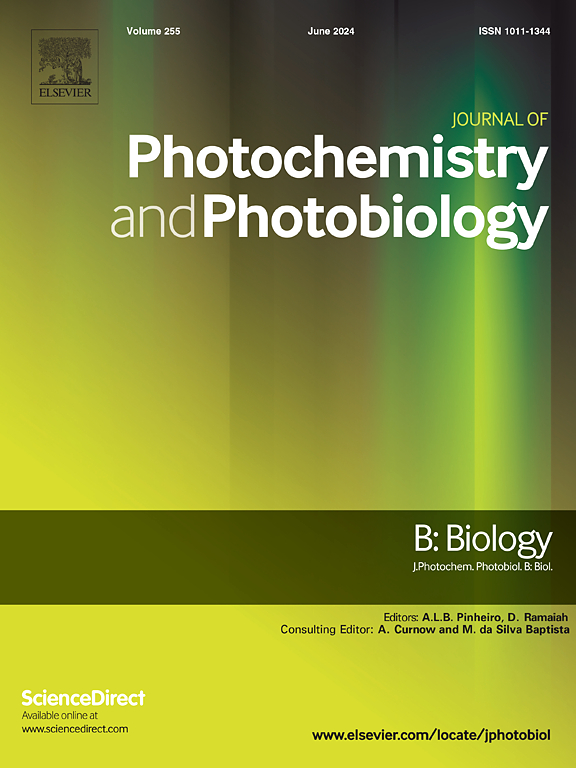辅助810纳米光生物调节与药物治疗三叉神经痛:在三级保健中心的随机对照试验
IF 3.7
2区 生物学
Q2 BIOCHEMISTRY & MOLECULAR BIOLOGY
Journal of photochemistry and photobiology. B, Biology
Pub Date : 2025-08-29
DOI:10.1016/j.jphotobiol.2025.113249
引用次数: 0
摘要
背景:三叉神经痛(TN)是一种使人衰弱的口面部疼痛疾病。卡马西平的药物治疗是主要的治疗方法,但副作用和耐受性往往限制其长期使用。低水平激光治疗(LLLT)在治疗各种神经性疼痛方面显示出希望,但没有研究评估其在印度人群中作为TN辅助治疗的有效性。方法在单中心随机对照试验中,将40例经典TN患者随机分为两组:I组单独使用卡马西平,II组使用卡马西平加LLLT(使用810 nm二极管激光,200mw,每点30秒)。在基线、1周、2周和3周使用数字评定量表(NRS)评估疼痛强度,在基线和3个月后使用McGill疼痛问卷评估疼痛强度。LLLT每周给药3次,持续3周,剂量为810 nm,每个照射点给药6 J。结果由盲法评估者评估。结果基线NRS评分相近(8.50±0.95比8.75±0.96,p = 0.412)。在3周时,II组的平均NRS(0.40±0.68)明显低于I组(3.45±1.23),p < 0.001。3个月时,II组的McGill评分(2.90±3.07)明显低于I组(23.40±6.38),p < 0.001。II组中没有患者需要在研究期间增加卡马西平剂量,而I组中所有患者都需要增加卡马西平剂量。结论与单用卡马西平相比,光生物调节联合卡马西平对TN患者的疼痛缓解效果明显更好,减少了对高剂量药物的需求。这是第一个证明LLLT作为印度人口TN辅助治疗的益处的研究,表明它是一种有希望的辅助治疗选择。本文章由计算机程序翻译,如有差异,请以英文原文为准。

Adjunctive 810 nm photobiomodulation with pharmacotherapy for trigeminal neuralgia: A randomized controlled trial in a tertiary care centre
Background
Trigeminal neuralgia (TN) is a debilitating orofacial pain disorder. Pharmacotherapy with carbamazepine is the mainstay of treatment, but adverse effects and tolerance often limit its long-term use. Low-level laser therapy (LLLT) has shown promise in managing various neuropathic pains, yet no study has assessed its efficacy as an adjunct in TN treatment within an Indian population.
Methods
In this single-center randomized controlled trial, 40 patients with classical TN were randomly allocated into two groups: Group I received carbamazepine alone, and Group II received carbamazepine plus LLLT (using an 810 nm diode laser at 200 mW for 30s per point). Pain intensity was assessed using the Numeric Rating Scale (NRS) at baseline, 1, 2, and 3 weeks, and the McGill Pain Questionnaire at baseline and after 3 months. LLLT was administered thrice weekly for 3 weeks at 810 nm, delivering 6 J per irradiation point. Outcomes were evaluated by a blinded assessor.
Results
Baseline NRS scores were similar (8.50 ± 0.95 vs. 8.75 ± 0.96, p = 0.412). At 3 weeks, mean NRS reduced significantly more in Group II (0.40 ± 0.68) than Group I (3.45 ± 1.23), p < 0.001. McGill scores at 3 months were significantly lower in Group II (2.90 ± 3.07) compared to Group I (23.40 ± 6.38), p < 0.001. None in Group II required carbamazepine dose escalation during the study, whereas all patients in Group I needed increases.
Conclusion
Combined photobiomodulation with carbamazepine provided significantly superior pain relief compared to medication alone in TN patients, reducing the need for higher drug doses. This is the first study to demonstrate the benefits of LLLT as an adjunct therapy in TN among the Indian population, indicating it as a promising option for adjunctive management.
求助全文
通过发布文献求助,成功后即可免费获取论文全文。
去求助
来源期刊
CiteScore
12.10
自引率
1.90%
发文量
161
审稿时长
37 days
期刊介绍:
The Journal of Photochemistry and Photobiology B: Biology provides a forum for the publication of papers relating to the various aspects of photobiology, as well as a means for communication in this multidisciplinary field.
The scope includes:
- Bioluminescence
- Chronobiology
- DNA repair
- Environmental photobiology
- Nanotechnology in photobiology
- Photocarcinogenesis
- Photochemistry of biomolecules
- Photodynamic therapy
- Photomedicine
- Photomorphogenesis
- Photomovement
- Photoreception
- Photosensitization
- Photosynthesis
- Phototechnology
- Spectroscopy of biological systems
- UV and visible radiation effects and vision.

 求助内容:
求助内容: 应助结果提醒方式:
应助结果提醒方式:


